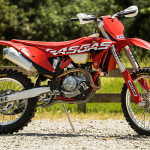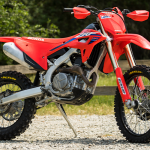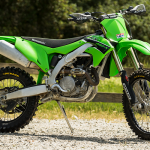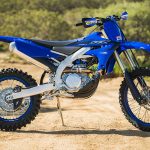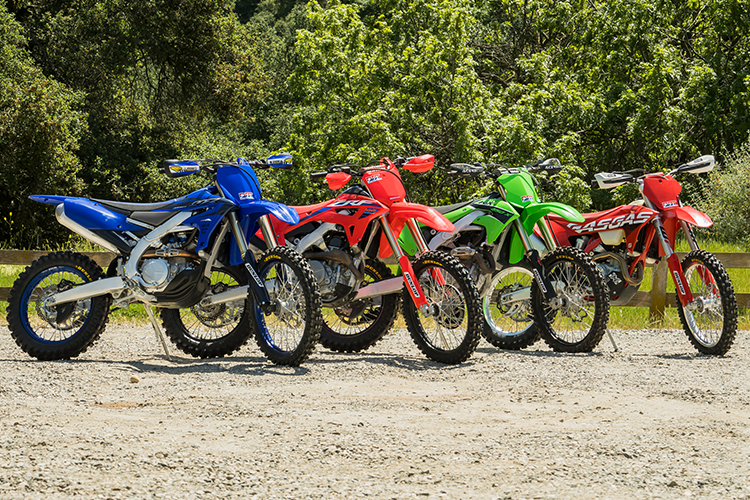
Competition off-road bikes are becoming more and more popular with the OEMs and the consumers at the ground level. KTM pioneered this decades ago, and now nearly every manufacturer produces their own XC racer in some shape or form. Some are closer to an MX model than others, but these are all declared as off-road race bikes from the factory, what we deem the “FX” category. Yamaha has the YZ450FX, Honda with the CRF450RX, Kawasaki brings the KX450X, and GasGas rounds out our comparison with the GasGas EX450F, a bike very similar to KTM’s 450 XC-F, though it’s now a generation behind in the chassis and engine department.
To checkout each rider’s individual opinion and ranking, click through below:
To checkout each bike’s First Impression, click through below:
YZ450FX | CRF450RX | KX450X | EX450F

Note: We tested each bike exactly how they come off the showroom floor, excluding tires. Knowing how important a tire is and how quickly it’ll be changed, we elected to go with the same tires on every bike. Dunlop helped us out with a MX33F/AT81 tire combo for all bikes. The MX33F is a much more compliant front tire and really helps in bump absorption and comfort with a lot of these bikes that don’t come stock with it. The only other changes we made were clicker and sag adjustments, ECU tuning on the Yamaha with the GYTR Power Tuner App or Kawasaki’s mapping plugs, and added handguards for some protection. This test was performed over two days at Glen Helen Raceway and the local off-road trails/track in Southern CA, though a few of the riders have some individual time on the different bikes at various races and other off-road riding spots prior to this.

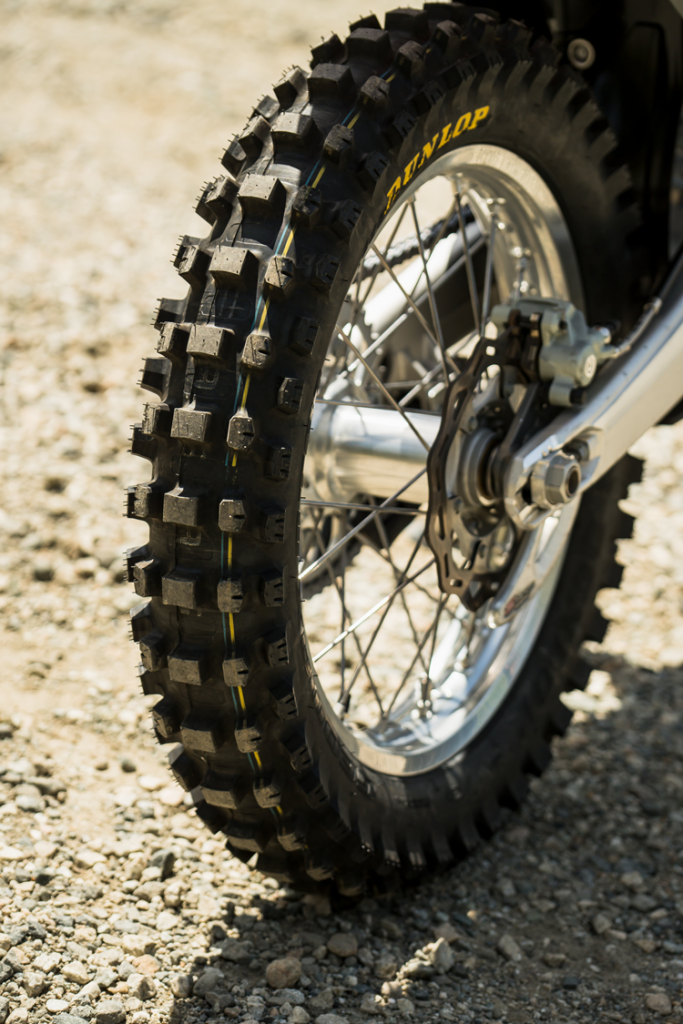
*We feel each bike could easily be raced in stock trim or very close to it, and we did this. Some may require a little extra setup time to get acquainted with the bike, but all are potent race machines and just about every rider had a tough time “ranking” these bikes.
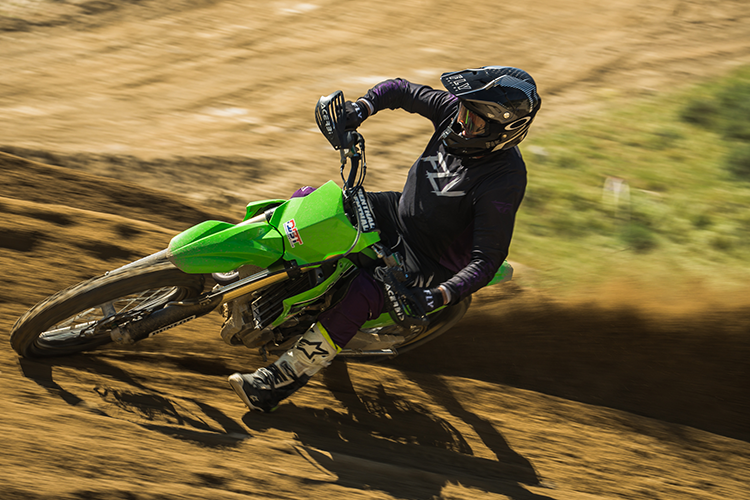
Rankings:
We really feel ranking bikes is the best method for you to decide anything. Read, watch and learn as we describe the characteristics of each bike to see if the traits are ones that may be suited to you. There really is no bad bike, there are just different bikes. However, everyone wants to see a winner and this is the only way we could determine how the bikes stand up when ranked by all of our riders. These are the scores that we came up with.
1. Kawasaki: 1+2+3+2+1+1+1+2 = 13
2a. Yamaha: 4+1+4+3+3+2+2+1 = 20
2b. Honda: 2+4+1+1+2+3+4+3 = 20
4. GasGas: 3+3+2+4+4+4+3+4 = 27
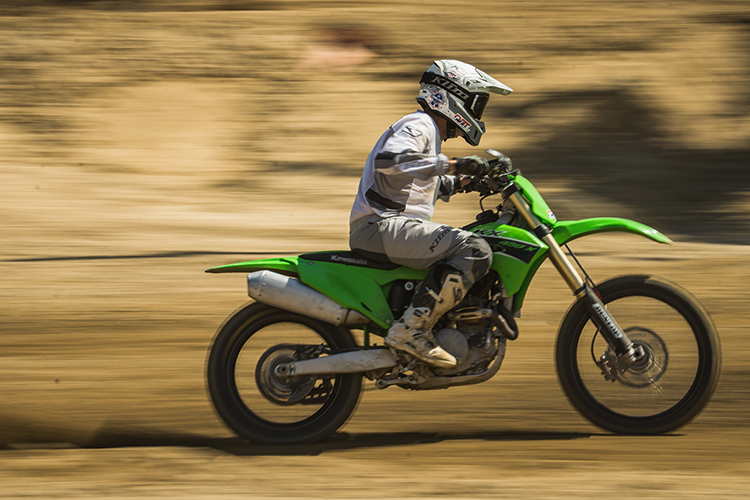
Power

Yamaha: To no one’s surprise, the Yamaha power plant is one of, if not the most powerful in its class. Yamaha has had a healthy engine since reversing its cylinder head design over a decade ago, but they’ve refined that power to a usable, all-around spread that no one should complain about as being too little. The biggest bonus, and it’s something that is still exclusive to Yamaha, is the GYTR Tuning App that the bLU cRU provides for FREE. The most beneficial aspect of this motor is the ability to completely tune it at your fingertips unlike any bike out there.
The YZFX packs a strong hit and almost too crisp throttle response, so much so that it can be tough to manage for some riders. The strong bottom end carries through the mid where it falls off a little quicker than some of the others on top, but it’s far from slow up there. The quick revving motor is very lively, torquey down low, and can be changed to fit your needs all with the GYTR Power Tuner app. The on-the-fly mapping switch is the easiest to use, with a quick push and you’re in the second map that doesn’t require changing couplers, coming to a stop, etc. Most of our vet riders really struggled with the Yamaha in general due to its power character, but once we changed the maps around, it really brought the entire bike around as a package and went from the least favorite to the top favorite with just a simple mapping change. While changing mapping greatly affects engine character, it also has a surprising effect of the chassis and handling feel as well.
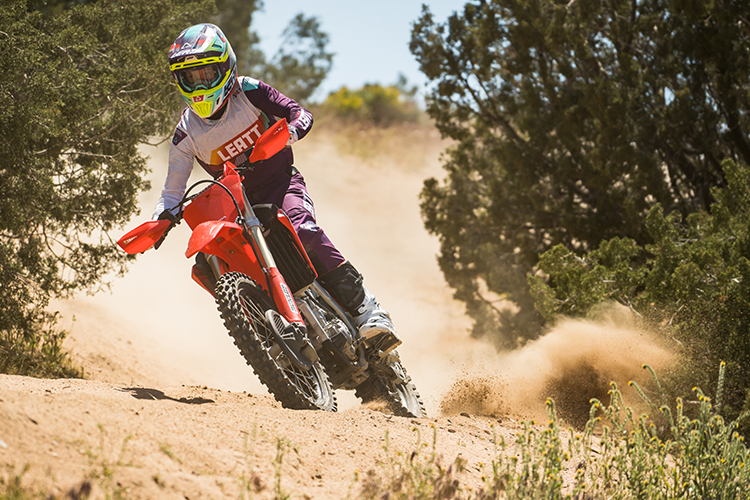
Honda: Honda’s updates for 2023 see a quick revving powerband that rivals that of the Yamaha in almost every way. The power is smooth and linear, yet powerful. The throttle feels an instant connection to the rear wheel. It pulls with authority across the board and is on the aggressive side for an off-road bike, but most everyone found themselves riding taller gears and really liking the output. In more technical terrain, the bike didn’t lug quite as good as some of the others, showing its MX roots with a light flywheel effect here. Also, in higher speed terrain, the CRF revved out the quickest of all these bikes. Plain and simple, the CRF motor is aggressive and fast, yet the refined power makes it more usable and rideable than it was just a couple of years ago.
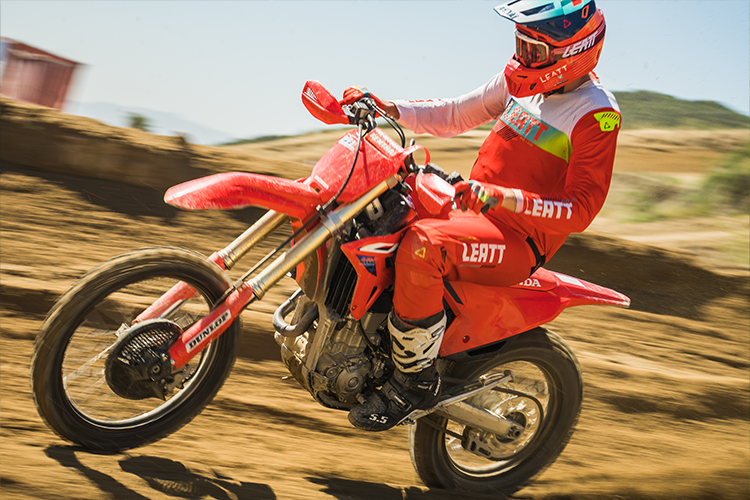
The Honda mapping switch could use some work. While it is “on-the-fly” adjustable, it takes a very concentrated effort to do so, and seemingly half the time we tried it without coming to a stop, we didn’t actually switch the maps at all. With that being said, the three different maps available are all different and we came to like each map in different ways. The stock Map 1 is a good all-around map that we tend to ride in 75% of the time. It does everything well and since it is harder to select different maps, we typically leave it in this one. Map 2, or the “mellow” map, is very smooth, torquey, and easy to ride. When trail riding or with novice/intermediate level riders on-board, we found this to be the map of choice. You can lug the bike, keep the rear wheel hooked up, and be smoother on the bike without a jerky power delivery that can get away from you in the tight stuff. Lastly, Map 3 or the “aggressive” map is fun to ride with a slightly harder hitting power down low. In faster, more open conditions some of our testers preferred this map as you could ride a gear taller through corners. Overall, all three maps work well and compliment each other, but Map 1 was the most favored by the majority of our testers.

Kawasaki: The KX motor is quite possibly the best of the bunch for the masses. It has a smoother, more broad delivery that doesn’t rev too quick or too slow, but rather just right for a lot of our riders. Like the CRF, it lacks some of the torque needed when speeds slow down, but the traditional four-stroke power builds progressively from bottom to top where it runs with the best of them. The KX doesn’t feel the fastest, but it puts the power to the ground very effectively and pulls hard throughout the revs. Overall, it has a very fun power that is accommodating to riders of all ages and skill levels. Like the Honda, the 5-speed close-ratio transmission makes it difficult to ride on extreme ends of the speed spectrum, but regearing the bikes can help accommodate and adapt to the terrain on hand.
The mapping options on the KX are changed through couplers, meaning there’s no ability to change while riding. Like the Honda, there are standard, mellow, and aggressive options and for the most part, we stuck to the aggressive or White coupler, even though it comes equipped with the mellow or Black coupler on the X model. Again, it allowed gear-high riding and a smoother pull when doing this.
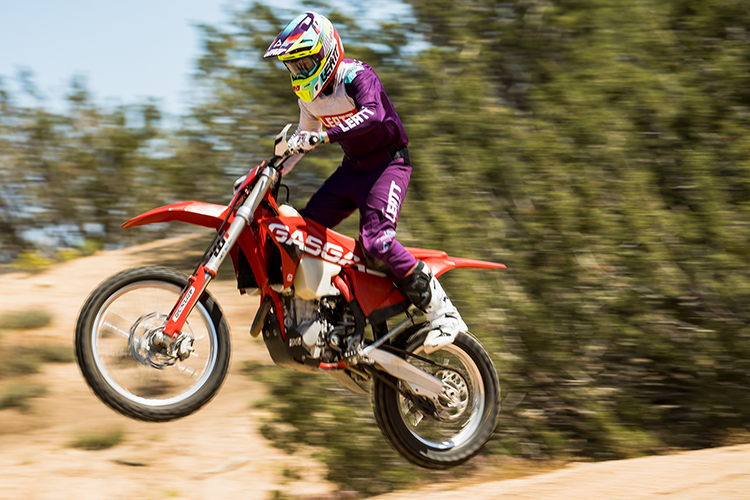
GasGas: The GasGas motor “feels” the slowest out of the four with an ultra smooth bottom end that spins up more slowly before it finds its legs in the mid-range and ramps up to a 350F-like top end. This meaning it really builds power with RPMs. While motocross and faster off-road riding will showcase this trait, the amount of torque put out in tight terrain is actually quite impressive.It is a heavier flywheel weight feeling and the only bike to have classic chugging four-stroke power. It’s like a hidden gem – once you find it and trust that it will not stall as easy as some of the other bikes, you want to use it more. But the bike is not “fast” down there. The motor is polarizing with a very impressive torque at the slowest speeds and quite possibly the most useable power on top end, but everywhere else is mediocre when ridden back-to-back with the Yamaha, Honda, and Kawasaki. Hyper aggressive riders (and lazy riders) enjoyed riding the higher RPMs, while trail riding and novice riders liked the smooth pulling, easy to ride low end that isn’t prone to stalling or ripping your arms out. However, most were looking for a more exciting and traditional 450cc four-stroke power that they can ride faster at a lower RPM and have their arms ripped out from time to time.
Unlike the KTM and Husqvarna, there is no mapping switch on the GasGas, though there is an accessory option available for purchase.
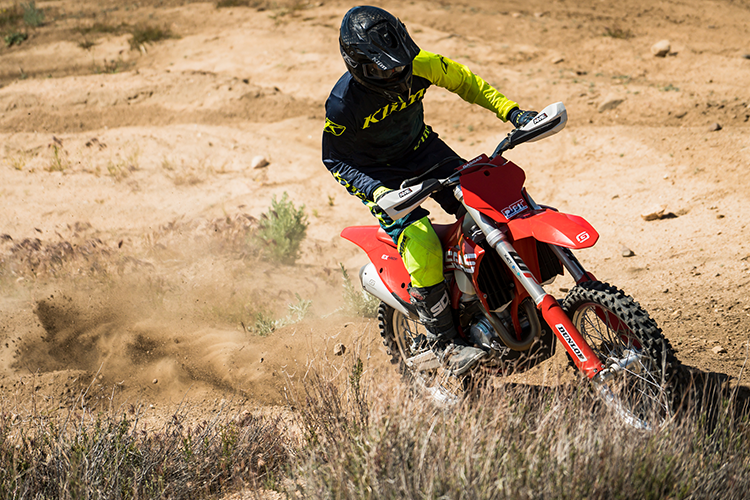
Where all four models differ greatly is in the transmission. The Yamaha boasts a wide-ratio, 5-speed transmission with everything from a granny first gear to a high speed fifth gear. The gaps are all pullable and the FX motor is strong enough to pull every gear without issue. The KX, CRF, and GasGas both carry over the exact transmissions from the MX models and are good for GP racing, but it doesn’t excel on the extreme ends of the spectrum like the Yamaha does.
The KX CRF, and GasGas feature hydraulic clutches while the YZF is the only one to boast a cable clutch – depending on the rider, a different one was favored by each but the GasGas was the most favored of the hydraulic clutches.
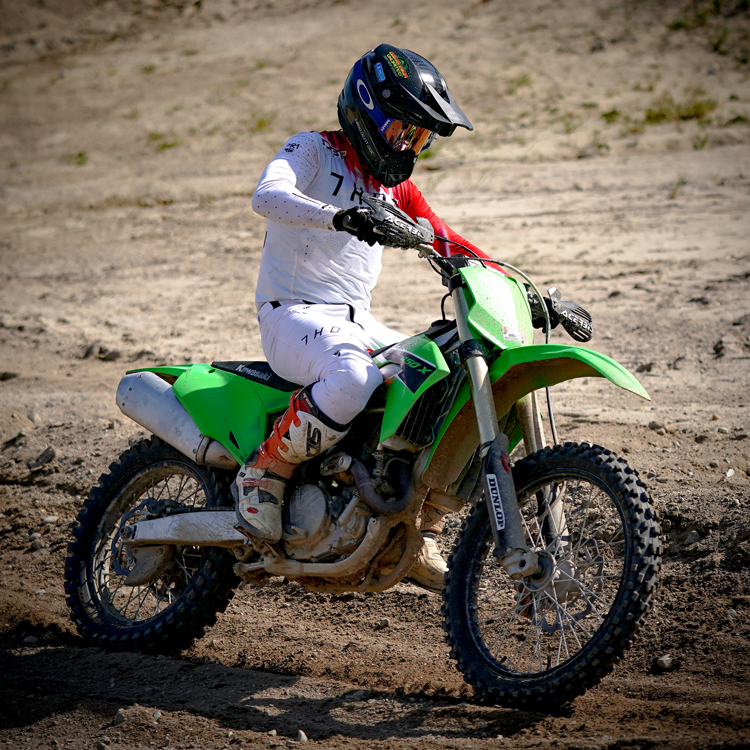
Suspension
Off-road suspension typically is soft and mushy, heavily favoring comfort over performance. However, the recent trend with a dedicated off-road race lineup has altered how the OEMs set up their suspension. These bikes are a little more tailored to take on some light motocross style riding and GP/GNCC/desert racing with stiffer settings than old school trail bikes of the past. In general, we’d say these bikes slightly favor GNCC type riding/racing over western conditions.

If you’re coming from trail bikes, you’ll feel these bikes are stiff; however, if you’re coming from a MX/race bike, you’ll feel these bikes are soft. The tricky thing about production off-road suspension is that its intended use varies so widely and it is nearly impossible to find a good do-it-all setting for the masses.
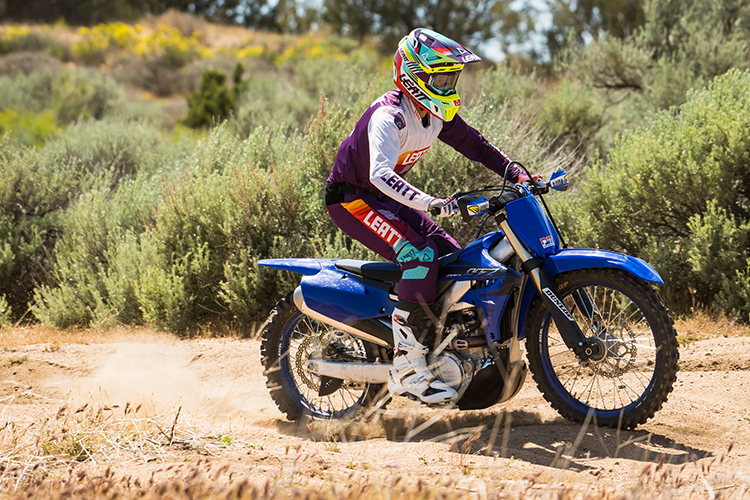
Yamaha: Yamaha has had a stranglehold on a lot of the media and customers alike raving about how well the suspension is set up stock for several years now. However, the YZ450FX wasn’t the standout best in the group across the board. Depending on the size and shape of the bump, the Yamaha either worked the best or not so great largely due to one thing – a soft fork spring. The softer fork spring, paired with stiff valving, worked really well in absorbing small chop, rocks, roots, etc., but suffered as the bump size increased. With the bigger bumps came more pitching and see sawing, exemplifying an unbalanced setup that really came to light with faster, heavier, or taller riders. Having experience with this, we know going up a spring rate in the fork would help this bike tremendously, but since it’s a stock test, we were left with this setup.

Honda: The Honda’s Showa components are the stiffest yet most balanced out of the four. They have a more rigid and heavily dampened feeling, true to Showa, but they have more comfort in their settings in the last year or so. The CRF gravitates to more motocross than true off-road, but tuning the clickers makes a noticeable difference and gives the bike a wide range to perform. Depending on the rider and terrain, we could always find a pretty good setting, and being on the West Coast, the Honda suspension was favored by a large majority of the riders when going fast. On the other hand, it beat you up on the trail and was a lot more particular than the other bikes in the comparison..
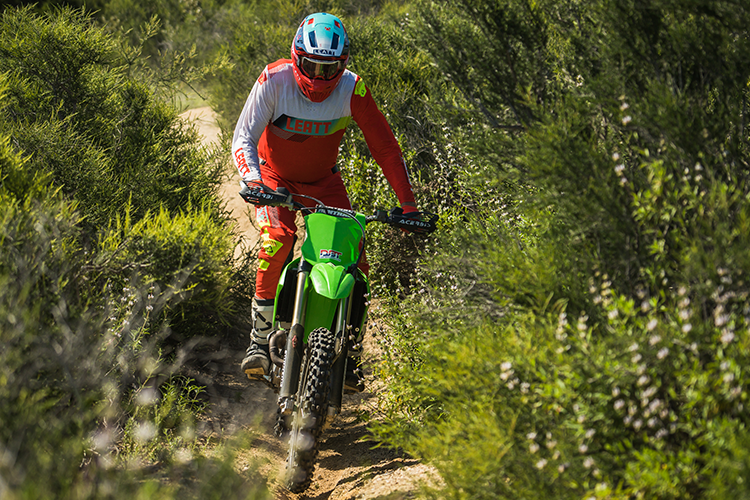
Kawasaki: The Kawasaki KX450X houses Showa spring components front and rear. Like the Yamaha, the KX felt unbalanced for faster GP racing and motocross, noting that the fork would ride low and dive on decel and in the rough stuff. While it worked better in more technical terrain, it lacked a little comfort and initial plushness as you would suspect. Still, the KX suspension felt average in that it wasn’t the worst and it wasn’t really the best for any of our riders.
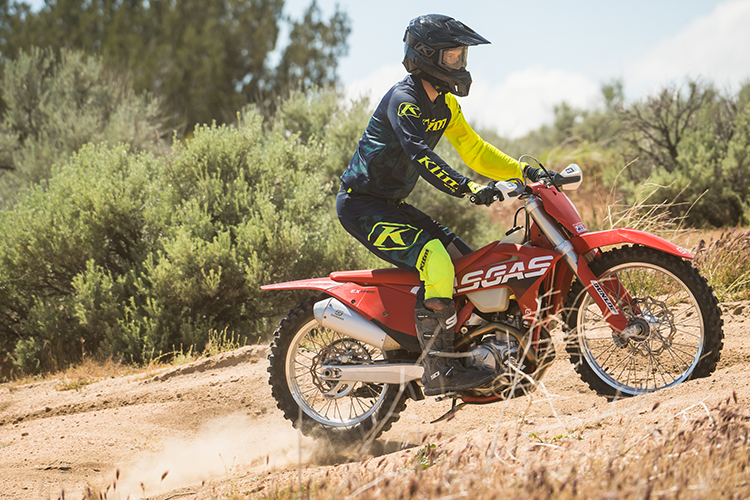
GasGas: The GasGas is the lone ranger in having a more traditional, softer setup – which isn’t necessarily a bad thing by any means. When the speeds are down, at times it’s one of the best working bikes as it’s very balanced, just soft. The softer settings, catered more towards a GNCC/woods setup soaks up small stuff very well. Likewise, the lightweight AER48 air fork is easy to maneuver, and adjusting the air pressure is very effective when trying to set the bike up for different skilled riders or terrains. So when other bikes suffered with a soft fork, the Gas Gas was fixed with a few PSI.
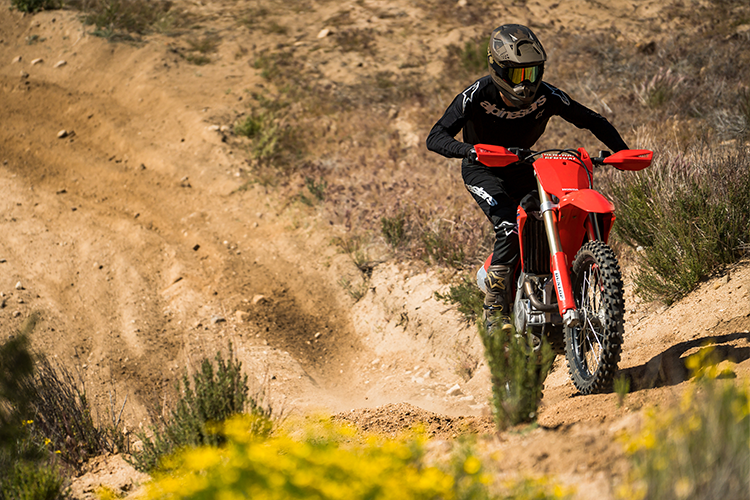
Most of our riders were able to bump up air pressure 5 psi to help increase bottoming resistance more and fine tune the rest with clickers. Surprisingly, both ends lack the bottoming performance that the rest of the bikes have and that used to be the standout feature of an air fork. One thing about the air fork is that it feels very different (not necessarily better or worse but definitely light weight on the front end would be the most common comment), and those who have less experience on air forks felt they needed more time to adapt and adjust to the feel of an air fork.
Handling
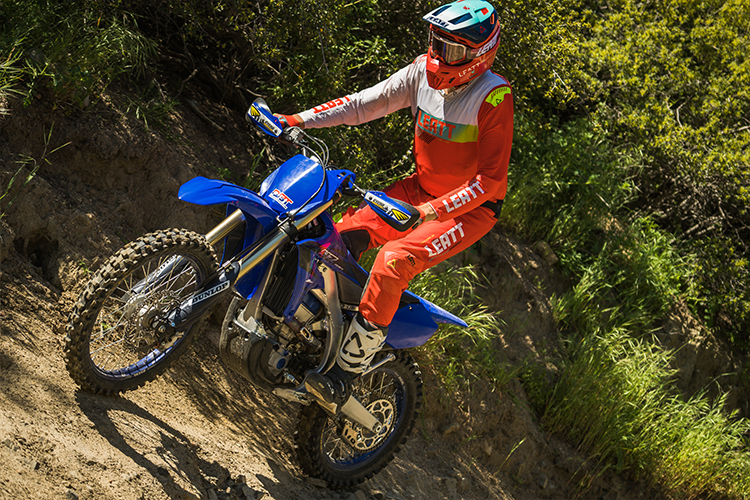
Yamaha: Despite it being the heaviest on the scale by a few pounds, most agreed the Yamaha felt to be one of, if not the lightest bike in the dirt. Its peppy motor and center of gravity give it a light feeling that’s fairly easy to maneuver and put where you want it. Of all the bikes, it’s one of the more stable options that uses its weight to keep itself planted and straight, but still allows you to carve corners when needed. Of all the bikes, it’s one of the harder bikes to corner, but that’s not saying much as it’s still a very good cornering machine. And for those who prioritize stability more than cornering, the Yamaha might be the bike for you.
Gone are the days where the Yamaha feels like a pig – most of our riders could jump on this bike and not feel any extra width after just a few minutes on this bike. The visual look of the tank/air box area has been improved but like the Honda it looks heavy up top. Where this Yamaha chassis really shines is as it gets rougher, its bump absorption becomes apparent in how it soaks everything up without getting twitchy and providing a lot of feedback to the rider.
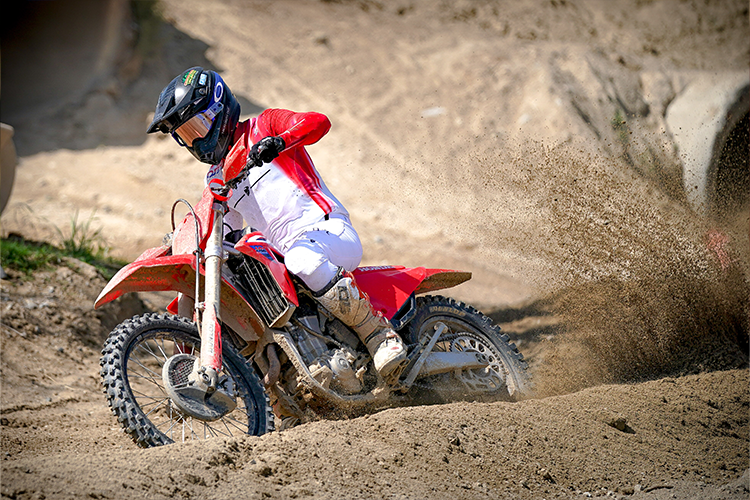
Honda: The Honda has the best cornering chassis of the group. It’s stiffer in nature and you feel more of the bumps and the ground through it, but you can cut down and maneuver the CRF with ease. We did feel it lacked some in the stability department, and simple things like running a little more sag (107-108mm) and dropping the forks in the clamps helped tremendously without giving up much cornering. The stock 2.2gal fuel tank on the CRF is the worst of the bunch, and most riders felt it hindered the bikes performance. It’s very top heavy and on the wider side, and several riders felt it when jumping on the Honda. IMS and Red Moto Racing all appear to have better gas tanks for this bike that could help the Honda a lot.

Of all the bikes, the Honda chassis felt the most different in how “rigid” it felt, though not in a bad way. It’s very precise, you can easily put the bike where you want it, and you feel a lot of what’s underneath you. Additionally, there’s a lot of emphasis and weight put on the front end that helps achieve this feel and its cornering ability, and it’s very apparent when ridden back to back with all the other bikes. This chassis is more preferred when there’s good traction and the bumps are more round than square, but it holds its own when the conditions start to go away.
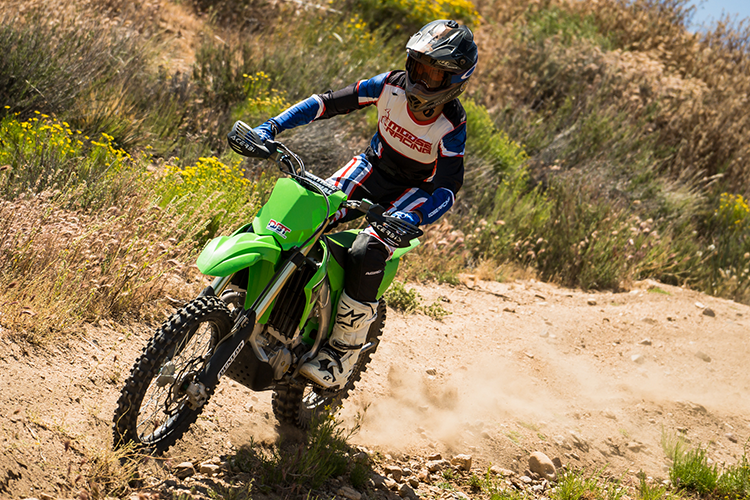
Kawasaki: The Kawasaki chassis is one of its highlights in how well it handles everything and appeals to a wide variety of riders. It has a slightly lighter front end feel that corners well, but doesn’t cut down like the Honda does. At times when there is nothing to bank off of, the front end can get vague mid-corner and push but it’s minimal. Likewise, it isn’t quite as stable as the Yamaha, though it’s close, but the chassis is forgiving and soaks up bumps better than almost any bike. Overall, the KX chassis just feels “loose” on the track, completely opposite of the Honda, but it doesn’t care that it’s loose. It almost always comes back to center and you don’t have to worry about it.
In stock trim, the already thin chassis of the KX paired with a stock moto tank made the bike feel slim, yet many thought it felt the heaviest on the track. Part of that is its power character, and part is just chassis feel. What surprised many of our riders is they actually liked that heavy chassis feel at the end of the day. You generally feel very in control of the bike with it being planted. One thing to note is the KX lacks a big tank, severely hindering its mileage and how far you can go on a tank of gas.

GasGas: The GasGas is the only steel-framed chassis in the group and no one had anything bad to say there. Paired with the softer suspension, it offers a lot of comfort to the rider. The light scale weight is felt on the trails, but at times it led to a skaty bike that liked to dance and move around a lot at speed. The consequences of having a lightweight bike, but you reap the rewards when turning, flicking, sliding, and looking for an agile setup where you can put the bike where you want it. It sits on the opposite side of the spectrum as the Yamaha, shining where the Yamaha lacks and faltering where the YZFX performs best.
In general, the GasGas handling was very neutral amongst our testers. No one had anything bad to say about it, but no one raved about it either – it just works.
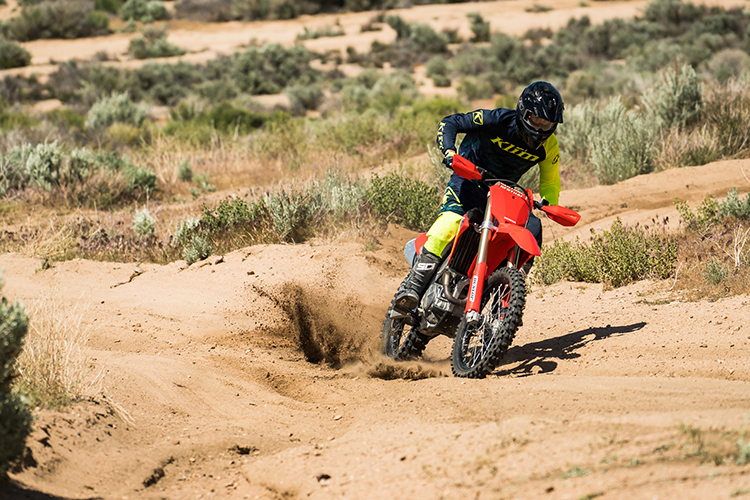
Notable Highlights
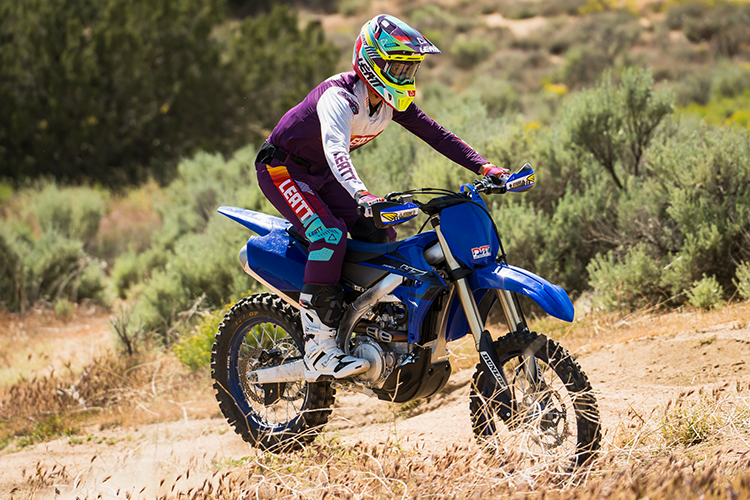
Yamaha: A few things stand out on the Yamaha, both good and bad. The 5-speed, semi-wide ratio transmission makes this bike the only one with a different tranny than the MX models. Since it has the power to pull it, this makes this bike so versatile in that you can go from high speed desert and GP racing/riding to tight woods and rocks and have a gear for everything without working the clutch or floating the valves. In general, the rider cockpit on the Yamaha is disliked for being small and cramped, with taller and narrower handlebars, a pocketed seat, and a close seat-to-peg ratio. Smaller riders actually liked this, but most average sized riders would benefit from a taller seat, different handlebars, and even lowered pegs. Another con the Yamaha faces is it doesn’t consistently start as quick as some of the other bikes do. It can hurt on dead engine starts and is just annoying when out riding or racing and you need to re-fire the bike. The Yamaha skid plate is the best stock plate in the bunch. The Yamaha air filter is easy to service, 2nd best in class.
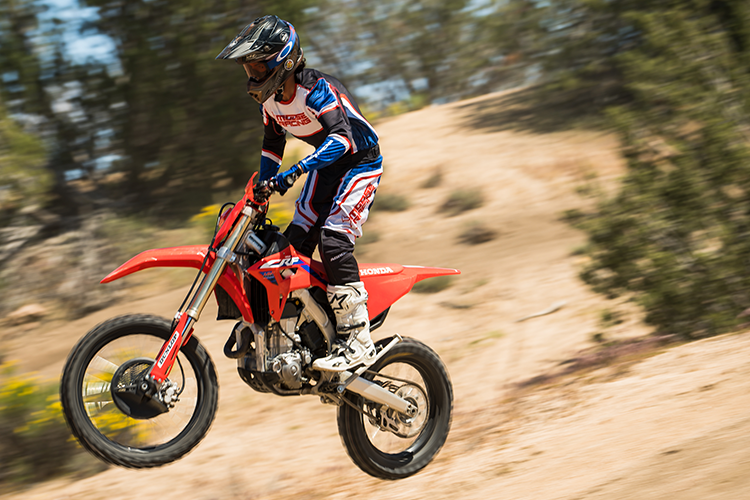
Honda: The Honda cockpit, aside from the bigger tank, is very easy to adjust to and is another favorite amongst these riders. The Honda front brake is very touchy and powerful, something riders either loved or liked. The back brake is also touchy and we found ourselves stalling the bike quite a bit more than expected due to this. The CRF is the only bike to come stock with handguards (and the KTM), but its skid plate is barely enough to deflect some roost off the front tire. The CRF air box is somewhat cramped and funky, but is better with time as you learn it.
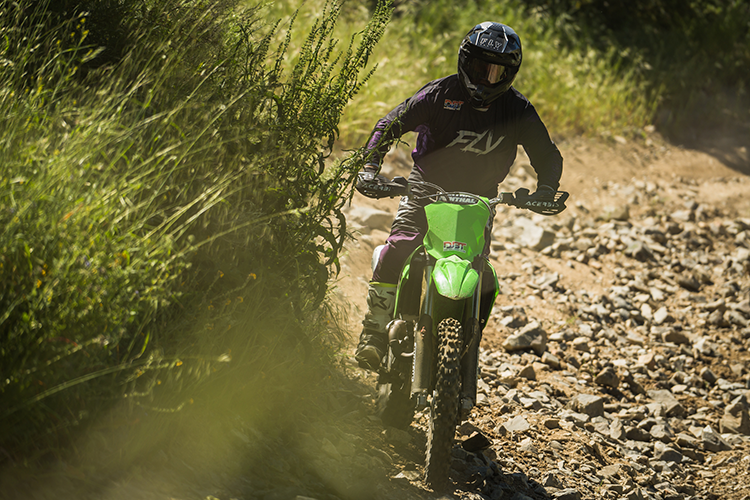
Kawasaki: The Kawasaki received a lot of praise for its ergonomics including seating position, handlebars, and rider triangle. Nearly every rider we’ve had to test this bike raves about how comfortable they feel immediately upon sitting on the bike. With that being said, nearly every rider has disliked the front brake lever on the KX. It is thin and very uncomfortable – to the point where it stood out and made some riders not want to use or touch the lever. Also, the stock Kawi grips are rock hard and nearly impossible to remove. The KX doesn’t come with handguards and like the Honda, the skid plate is nearly non-existent. The stock kickstand is more than bulky and like the levers, stood out to every rider in a bad way. Air filter maintenance is a pain on this and we typically found ourselves cleaning dirt out of the airboot after every filter removal.
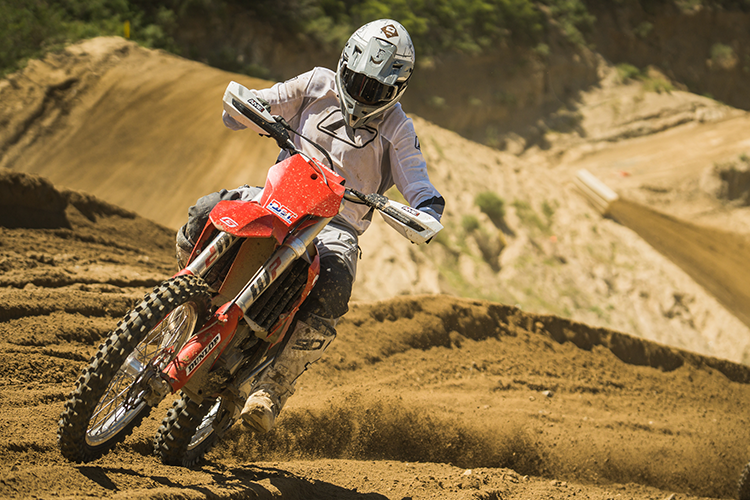
GasGas: The GasGas cockpit is very neutral – no one complained but no one was overly impressed, it just gets the job done. The Brembo brakes are a standout and pieces like stainless steel brake lines are a nice touch. The EX450F doesn’t come with a skid plate or handguards stock (KTM comes with both). The GasGas air filter, and most maintenance in general, is just simpler and easier on the GasGas which makes late nights in the garage not so late anymore.
Conclusion
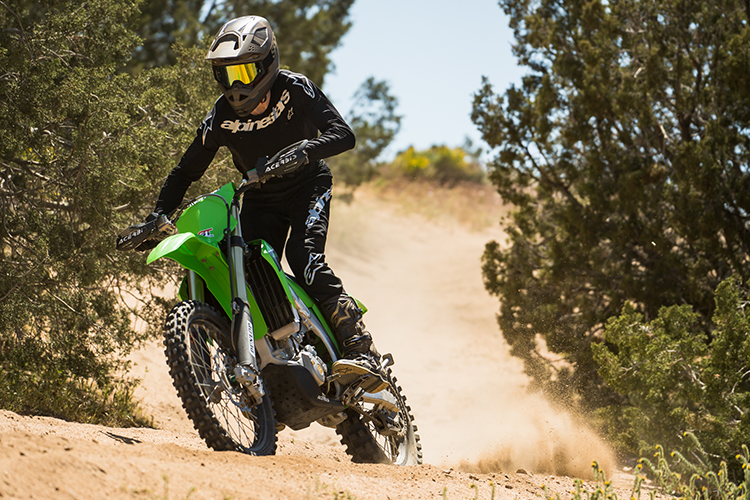
In general, the Yamaha is most different from its MX counterpart. The biggest changes are the wide ratio transmission while also boasting off-road specific suspension settings, ECU settings, and the usual gas tank, kickstand, 18 inch rear wheel, etc. The Kawi is the least changed with really just an 18 inch rear wheel, kickstand, and slightly softer suspension making the change.
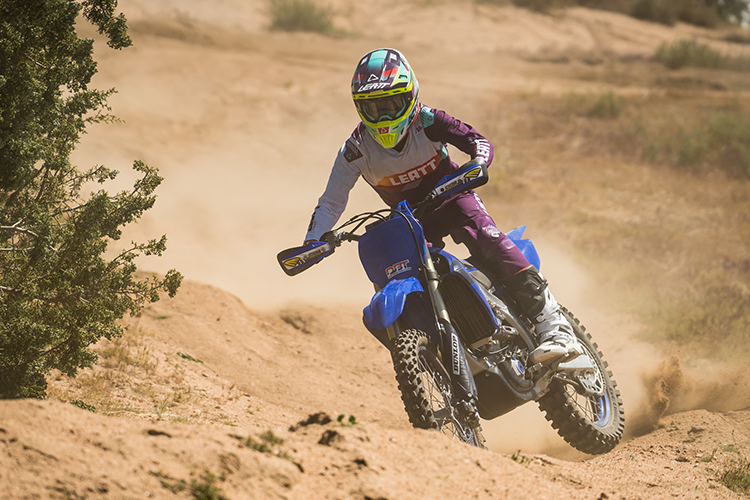
If there is anything we’d like to see on all these bikes moving forward, off-road ready skid plates and handguards would be easy, welcomed additions. Well designed larger capacity gas tanks and six-speed transmissions would be wins across the board, but these are costly additions for sure. We’d even settle for 5-speed wide-ratio transmissions but many riders do not like the gaps that appear in some designs.
While these bikes are all advertised as “off-road” bikes, they are all more than capable on a motocross track. And in some instances, they are better for consumers than the dedicated motocross model. Vet and novice riders alike can find the value of slightly softer suspension and easier to ride power when riding on motocross tracks and frequenting off-road trails. Being that these are 450’s, even our higher level riders appreciate the mellow power on the motocross track and resort to personalizing the suspension setup to make it MX friendly.
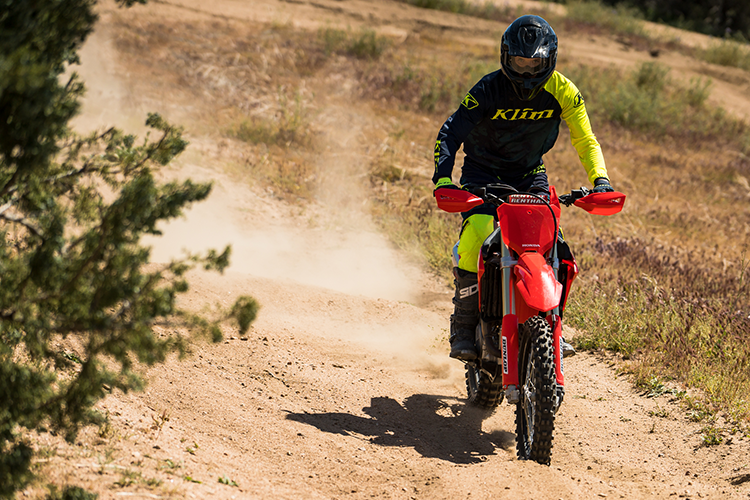
The best bike for you is here, you just have to assert your priorities and preferences to determine what bike that is. At the end of the day, all four of these bikes are more than capable and there truly is no bad bike anymore. Over the next month or two, we’ll be taking all these bikes and modifying them with some of the basics like suspension, ECU remaps, etc and performing a second part to this comparison to see how they rank when setups are tweaked to remove the things we complained or struggled with.
Individual Opinions
Bio: Jimmy Lewis
Ability: 50+ Off-Road Expert
Age: 55
Weight: 195lbs
Height: 6’0
Current Bikes: 2021 500 EXC
Ranking: KX450X, YZ450FX, EX450F, CRF450RX
Bio: Trevor Hunter
Ability: Off-Road Pro
Age: 24
Weight: 160lbs
Height: 5’7
Current Bikes: KX450X/CRF450RX
Ranking: KX450X, YZ450FX, CRF450RX, EX450F
Bio: Brent Farrell
Ability: 50+ Off-Road Expert
Age: 53
Weight: 220lbs
Height: 6’6
Current Bikes: 2021 Husqvarna FX450
Ranking: KX450X, CRF450RX, EX450F, YZ450FX
Bio: Todd Davis
Ability: 50+ Off-Road Expert
Age: 53
Weight: 210lbs
Height: 6’0
Current Bikes: 2023 KTM 450 XC-F
Ranking: CRF450RX, EX450F, KX450X, YZ450FX
Bio: Jeff Belknap
Ability: 40+ Off-Road Expert
Age: 49
Weight: 190lbs
Height: 5’10
Current Bikes: 2023 Suzuki RM-Z250, 2009 CRF450X
Ranking: CRF450RX, KX450X, YZ450FX, EX450F
Bio: Matt Mattoon
Ability: Off-Road Intermediate
Age: 26
Weight: 166lbs
Height: 6’0
Current Bikes: YZ250FX
Ranking: YZ450FX, KX450X, CRF450RX, EX450F
Bio: Tyler Belknap
Ability: Off-Road Pro
Age: 21
Weight: 165lbs
Height: 6’1
Current Bikes: 2022 YZ250FX
Ranking: KX450X, CRF450RX, YZ450FX, EX450F
Bio: Gunnar Carlson
Ability: Off-Road Expert
Age: 21
Weight: 155lbs
Height: 5’10
Current Bikes: 2022 Husqvarna FX350
Ranking: KX450X, YZ450FX, EX450F, CRF450RX
Do You Like DBT Bringing You Fresh Content? Search and Shop Through the Links Above or Below:
